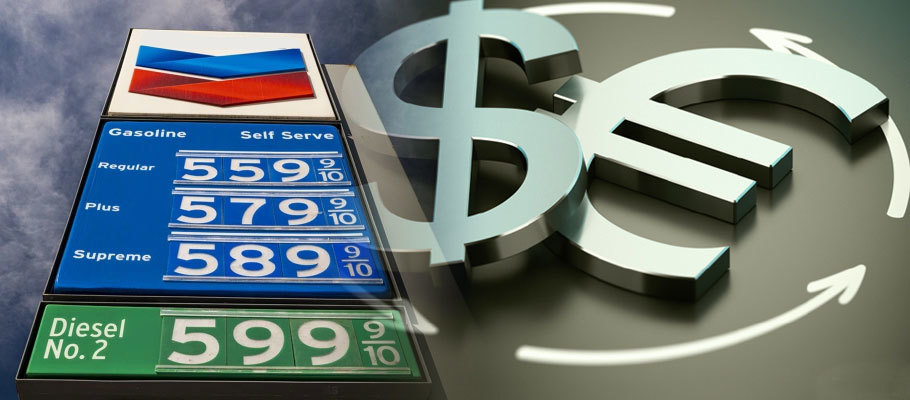
Published: November 23rd, 2022
Europe’s TTF natural gas benchmark price for month-ahead delivery climbed back to 114 per MWh at the start of the week, having sunk as low as 98 in late September.
HSBC’s currency strategy unit wrote in a market analysis that ‘natural gas prices are already beginning to rise. As temperatures on the continent start to drop it might pull EURUSD lower too’.
Bank analysts say the rise in gas prices arrives just as European weather belatedly starts to cool. An unusually mild Autumn enabled countries to top up their Winter gas reserves since less gas was used than is normal for this time of year.
‘The French December TTF contract rose by 18 per cent last week as cooler weather arrived in northern regions,’ HSBC added.
The combination of replenished gas reserves and dropping gas prices has eased fears that the Eurozone might run out of gas this winter. That positive sentiment has helped drive the single currency’s recent recovery against the Greenback.
The Euro dropped against the US Dollar and other G10 major currencies as the fallout from Russia's invasion of Ukraine took hold. The international sanctions regime and Russian response had investors worried that Russian gas supplies might be cut off entirely.
With the Nordstream 1 pipeline damaged by sabotage and the Nordstream 2 still un-commissioned, only limited amounts of Russian gas are arriving in Europe. Sometimes through smaller pipelines, other times via intermediaries who jack up the price while playing middleman.
Hans Schmieding, Chief Economist at Berenberg Bank, told Reuters that the war against Ukraine had caused energy and food prices to spike. 'When Russia began to close Nordstream 1 in late June, we predicted that a Eurozone recession would likely result.’
The Euro to Dollar rate sank to a multi-year low of 0.9532 on 29th September but has since rebounded to 1.0249 thanks to the Greenback’s broader turn-around.
At mid-year traders were counting on intervention from the European Central Bank (ECB) to beat an already hawkish market and sustain its recovery before new US inflation data was released.
On 5th June the single currency stayed above 1.06 against the greenback, gaining substantial support from a hawkish market that was re-pricing its expectations for ECB interest rate action in advance of the central bank’s June policy meeting. The meeting announced a winding down of Frankfurt’s last and longest running quantitative easing (QE) programme, while providing insights into the likely future path of European interest rates.
However, forex traders remained focused on anything that signals the ECB’s likely policy direction in late Autumn, particularly any guidance about the lift Eurozone interest rates might get as economic conditions evolved.
In a note to investors, Barclays European Economics Unit said at the time that EUR/USD could rise ‘thanks to a more hawkish European Central Bank coming out of Friday’s meeting and a weaker Dollar. In that scenario we believe upside resistance at 1.0789 will be tested.
‘We will be closely monitoring post–meeting communications for indications that the tightening cycle is going to become more aggressive. There is even a small possibility that the ECB decides to raise rates.’
ECB Governing Council members have spent much of the year publicly debating whether to raise the benchmark in standard 0.25 per cent steps or by larger 0.50 per cent increments in the wake of the ECB’s shuttering of its pandemic-driven QE programme.
FX Analysts at CIBC Capital Markets said that ‘inflation is much higher now than it was before the (June) forecast update. As a result, (ECB Chair Christine) Lagarde may consider a more aggressive response than standard 25bps increases.'
'If that occurs it could add support to EUR’s climb back against the Dollar and Pound.’
Eurostat figures in June showed the Eurozone inflation rate climbing to a new record of 8.1 per cent, significantly closing the gap between price growth levels in the Eurozone and those in America, where annual inflation was touching above eight per cent.
EUR started 2022 driven up by political tailwinds out of Italy, when markets reacted warmly to the appointment of neoliberal technocrat Mario Draghi as Italian Prime Minister.
After President Sergio Mattarella was re-elected in January, analysts thought the election result would establish policy continuity and enable Draghi to move ahead with EU-mandated policy changes required to obtain EUR 200 billion in EU funding.
Analysts at the time said Mattarella’s return to power was positive news for markets and a euro rally off the back of the news got underway. The EUR/USD rate also rose from a multi-month low seen the previous week.
It was clear however that chart trends were still favouring USD in the short term, with the future outlook depending then, as now, on announcements from the next ECB policy meeting.
Frankfurt avoided making major changes to interest rate policy at its February meeting, but did flag its concerns about early indicators of rising inflation, both in the Eurozone and globally.
Consensus at the time looked for ECB bankers to raise rates by the end of this year, with the Euro outlook driven by whether or not Frankfurt policymakers met that expectation.
A market analysis of Euribor prices suggested that investors were moving their expectations for the timing of an ECB rate rise forward, with December 2022 seen as the most likely date. This was, of course, all before the conflict in Ukraine and its knock-on effects to energy and food prices.
At the time, Frankfurt kept its dovish approach on expectations that inflation would fade by mid-year and that any risk of inflation staying above the bank’s two per cent target was small.